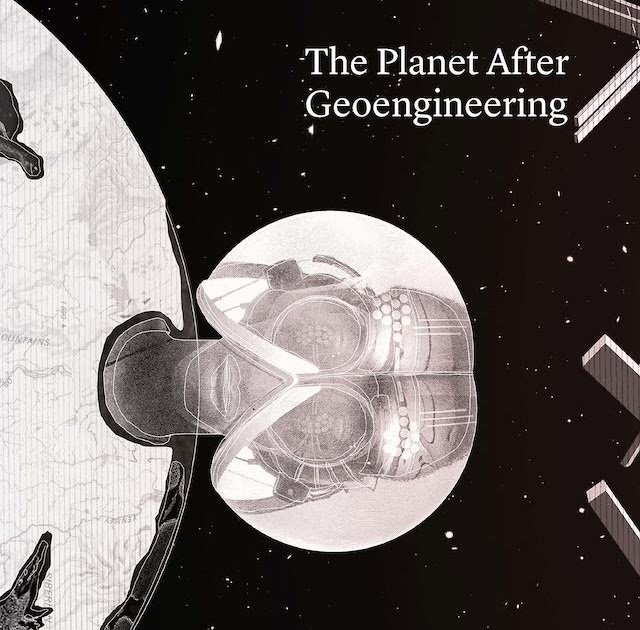The Planet After Geoengineering
The Planet After Geoengineeringby Design Earth (Rania Ghosn, El Hadi Jazairy)Actar Publishers, July 2021Paperback | 8-1/2 x 10 inches | 112 pages | 92 illustrations | English | ISBN: 9781948765961 | $29.95PUBLISHER'S DESCRIPTION:The term “geoengineering” refers to technologies that counteract the effects of anthropogenic climate change by deliberately intervening in Earth systems. In the midst of a climate crisis, and with disparate views on whether planetary-scale design is the appropriate response at all, The Planet After Geoengineering employs a speculative fiction approach to think with and against geoengineering as a form of planetary management. The graphic novel makes climate engineering and its controversies visible in a series of five stories that are collectively assembled into a planetary section from the deep underground to outer space. Each geostory —Petrified Carbon, Arctic Albedo, Sky River, Sulfur Storm, and Dust Cloud— depicts possible future Earths that we come to inhabit on the heels of a geoengineering intervention all while situating such promisory visions within a genealogy of climate-control projects from nineteenth-century rainmaking machines and volcanic eruptions to Cold War military plans. Such fabrications of an engineerable earth open a space to forge a new geo-politics that includes the actual Earth —its dimensions, processes, and lifeforms— as constitutive of design and the planet.Design Earth is an architectural research practice that engages representation as a speculative medium for making visible and public the geographies of the climate crisis. Rania Ghosn (Lebanon, b. 1977) is Associate Professor of Architecture and Urbanism at the Massachusetts Institute of Technology. El Hadi Jazairy (Algeria, b. 1970) is Associate Professor of Architecture at the University of Michigan.REFERRAL LINKS: dDAB COMMENTARY:This year's Venice Architecture Biennale, delayed from 2020 due to the pandemic, is the first one I haven't attended since 2012, the first year I started covering them for World-Architects. One of the many things I miss from not being able to attend the vernissage this year is the glut of catalogs and other publications from the main exhibition, national pavilions, and other displays I would amass. I would have to leave room in my suitcase when heading to Venice, just so I had enough room for all of the printed matter I couldn't pass up when traversing the Arsenale and Giardini. These publications, which vary from pamphlets and periodicals to full-blown books with ISBNs, are great reminders of the events, but they are also helpful in elucidating content or perspectives I might have missed in the too-fast scramble to see everything on display. The value of exhibition catalogs is much different when they are divorced from a personal viewing of the exhibition. They become standalone publications rather than companions, regardless of how they were designed. Since I didn't see this year's exhibition, How will we live together? curated by Hashim Sarkis, my impressions of its contents are limited to others' accounts and books like The Planet After Geoengineering, which is the contribution by Design Earth — one of 112 participants in the main exhibition. I'm not sure what form Design Earth's display in the Biennale takes — it could be a mix of drawings on the wall and a film, if the video below is any indication — but the book opts for a graphic novel format. Five scenarios for geoengineering the planet in response to climate change are presented across five chapters, each one indicating the reasons, scenarios, technologies, and after effects of large-scale approaches to manipulating the earth's climate.As a graphic novel, The Planet After Geoengineering is excellent: beautiful and breezy but very intelligent. It is saturated with the recognizable drawings by Rania Ghosn and El Hadi Jazairy, accompanied by just a few lines of text per spread to help tell the stories: of industrial vacuum plants sky-mining carbon dioxide in "Petrified Carbon"; of a huge methane-trapping biome at the North Pole offsetting permafrost depletion in "Arctic Albedo"; of rainmakers priming clouds with particles of silver iodide in "Sky River"; of nuclear bombs being detonated in volcanoes to recreate the cooling clouds of massive blasts from eons ago in "Sulfur Storm"; and of a layer of space dust formed from asteroids circling the earth to cut down on solar radiation in "Dust Cloud." That these and other scenarios are imaginable and foreseeably done with the technologies of today or the near future is both fascinating and terrifying. They are evidence of humanity's potential but also of how misguided such technologies and world views can be. Will geoengineering be pursued so people in first-world countries can continue to live the comfortable lives enabled by carbon-spewing cheap energy? Or is it for more benevolent ends: as a means of saving humanity as well as the diversity of species that also live

by Design Earth (Rania Ghosn, El Hadi Jazairy)
Actar Publishers, July 2021
Paperback | 8-1/2 x 10 inches | 112 pages | 92 illustrations | English | ISBN: 9781948765961 | $29.95
PUBLISHER'S DESCRIPTION:
REFERRAL LINKS:





